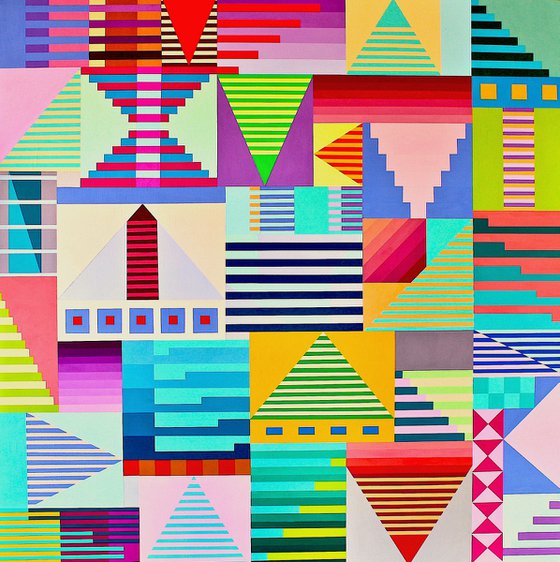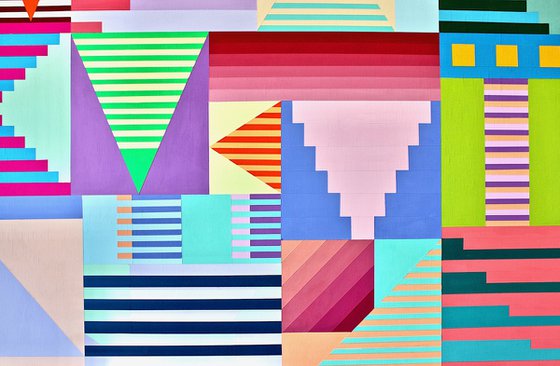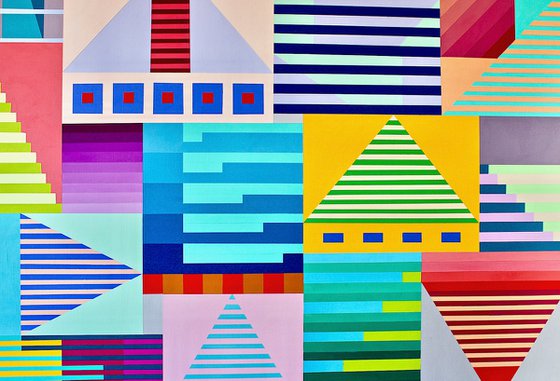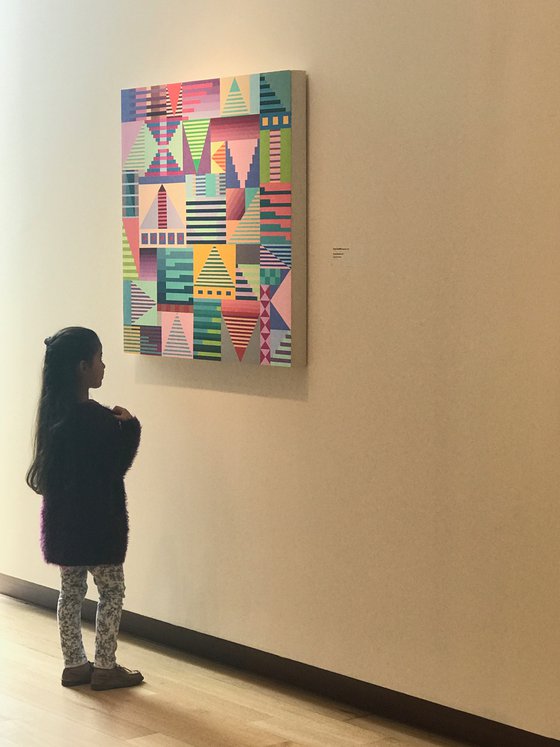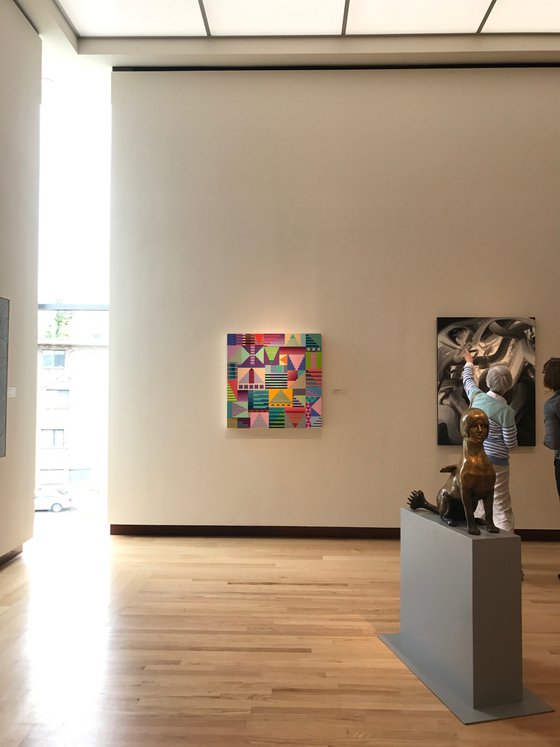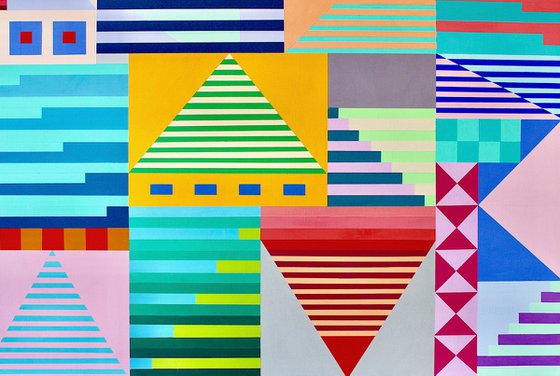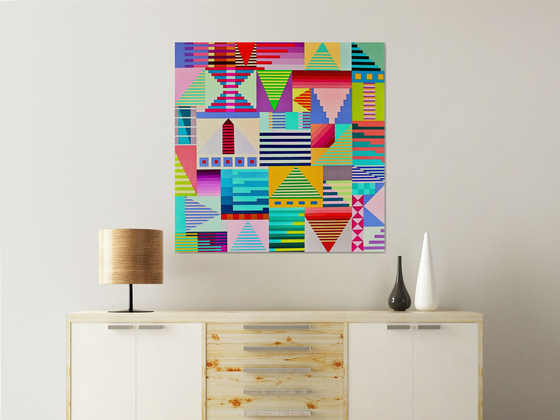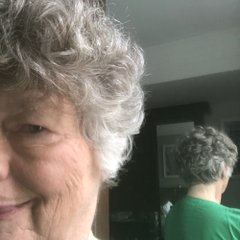- By medium
- By subject
- By budget
- Sales
- Gift cards
- Discover all art
- Artists
- Editors’ picks
- Ideas
Original artwork description:
This body of work is an extension of the tradition that was advanced in the 1960s and 70s, variously known as hard-edge abstraction or colorfield painting (but at times identified as minimal, cool, post-painterly, etc.). That work was derived from earlier twentieth century non-figural abstraction classified as de Stijl, Neoplasticism, Russian Constructivism, Orphism, and late-Cubism.
While I haven’t abandoned the easel and use paintbrushes, the surface is devoid of perceptible texture and traces of paint-handling, except for the slight ridges caused by the removed tape. Each work is on a cradled birchwood panel and should remain unframed. I use acrylic gouache (low-binder, non-reflective, absorbent color). Triangles, squares, rectangles, rhomboids, and trapeziums are arranged in autonomous, non-hierarchical patterns that structure the compositional field across the entire surface. My subject is color and line, and the energy that arises through the juxtapositions created by abrupt transitions between pattern areas. Patterns are used repeatedly across separate works, although not bound by color or scale. I think of each pattern as a block reminiscent of a batik tjap, or a syntactical unit such as a prepositional phrase or a subject and its predicate; thus the vocabulary of these works is comprised of fundamental, interchangeable, yet variable, units.
Where a pattern is placed in relation to others in any given work, as well as variations in color and scale, offers infinite possibilities for structuring the surface. While clarity of design has been a frequent goal of geometric abstract artists, because I use up to three dozen patterns in any given work, the complexity multiplies exponentially.
Geometric abstraction is an extension of the movement away from gestural, expressionist abstraction, a movement advanced by artists such as Barnett Newman, Kenneth Noland, Frank Stella, and Ellsworth Kelly, and to a less degree, Mark Rothko and Richard Diebenkorn. Several predecessors are important to me, particularly Victor Vasarely, Piet Modrian, Wassily Kandinsky, Paul Klee, Kasimir Malevich, and Islamic art in general. Among contemporary artists, I value the the paintings of Sarah Morris, Dion Johnson and John Matt and Bridget Riley.
Tags:
#contemporary #colorful #modern #geometrical #dynamic #contemporary american woman artist #abstract geometrical #op-art #hard-edge abstract paintingPyramid Musette (2017) Acrylic painting
by Gray Jacobik
1 Artist Reviews
£1,407.85
- Acrylic painting on Panel / Board / MDF
- One of a kind artwork
- Size: 91.44 x 91.44 x 6.35cm (unframed) / 91.44 x 91.44cm (actual image size)
- Ready to hang
- Signed on the back
- Style: Geometric
- Subject: Abstract and non-figurative
Loading
Original artwork description
This body of work is an extension of the tradition that was advanced in the 1960s and 70s, variously known as hard-edge abstraction or colorfield painting (but at times identified as minimal, cool, post-painterly, etc.). That work was derived from earlier twentieth century non-figural abstraction classified as de Stijl, Neoplasticism, Russian Constructivism, Orphism, and late-Cubism.
While I haven’t abandoned the easel and use paintbrushes, the surface is devoid of perceptible texture and traces of paint-handling, except for the slight ridges caused by the removed tape. Each work is on a cradled birchwood panel and should remain unframed. I use acrylic gouache (low-binder, non-reflective, absorbent color). Triangles, squares, rectangles, rhomboids, and trapeziums are arranged in autonomous, non-hierarchical patterns that structure the compositional field across the entire surface. My subject is color and line, and the energy that arises through the juxtapositions created by abrupt transitions between pattern areas. Patterns are used repeatedly across separate works, although not bound by color or scale. I think of each pattern as a block reminiscent of a batik tjap, or a syntactical unit such as a prepositional phrase or a subject and its predicate; thus the vocabulary of these works is comprised of fundamental, interchangeable, yet variable, units.
Where a pattern is placed in relation to others in any given work, as well as variations in color and scale, offers infinite possibilities for structuring the surface. While clarity of design has been a frequent goal of geometric abstract artists, because I use up to three dozen patterns in any given work, the complexity multiplies exponentially.
Geometric abstraction is an extension of the movement away from gestural, expressionist abstraction, a movement advanced by artists such as Barnett Newman, Kenneth Noland, Frank Stella, and Ellsworth Kelly, and to a less degree, Mark Rothko and Richard Diebenkorn. Several predecessors are important to me, particularly Victor Vasarely, Piet Modrian, Wassily Kandinsky, Paul Klee, Kasimir Malevich, and Islamic art in general. Among contemporary artists, I value the the paintings of Sarah Morris, Dion Johnson and John Matt and Bridget Riley.
Tags:
#contemporary #colorful #modern #geometrical #dynamic #contemporary american woman artist #abstract geometrical #op-art #hard-edge abstract painting14 day money back guaranteeLearn more
